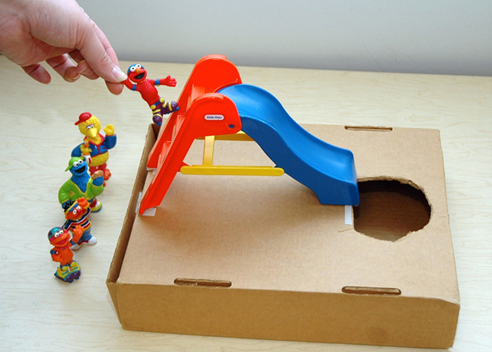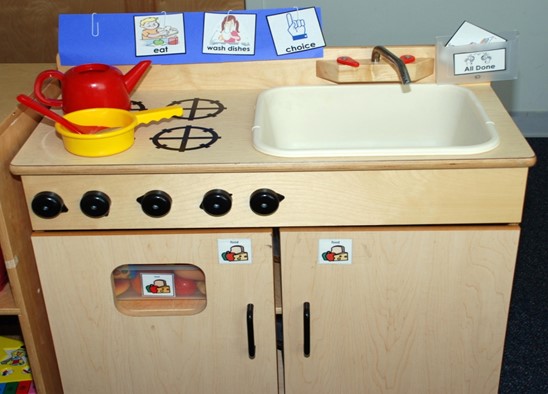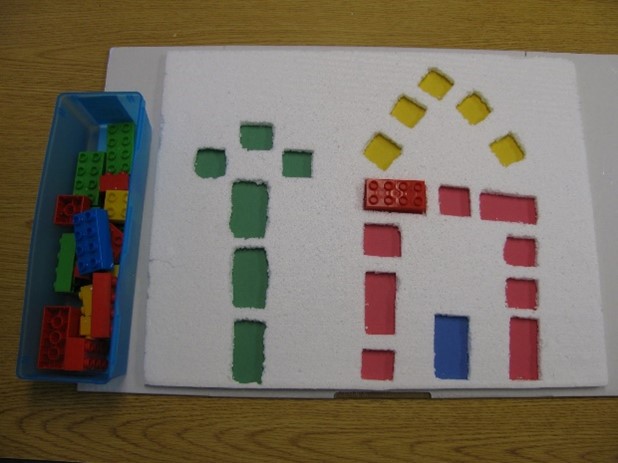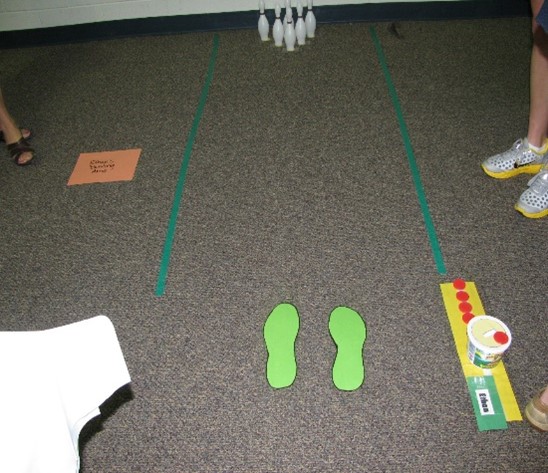Description of the video:
0:02
hi I'm Amy Gaffney I'm an educational
0:05
consultant and a speech language
0:06
pathologist with the Indiana Resource
0:08
Center for Autism today I want to talk
0:11
with you about playing with your child
0:12
children with autism want to play but
0:15
they don't always know how they need to
0:18
be taught some of the play skills and
0:20
remember play needs to be fun
0:23
so how do we start
0:25
well we can show our child how to play
0:28
with certain toys and have them imitate
0:31
us if we're going to drive the car
0:34
around the cone
0:37
go around and see if they will imitate
0:40
us and they can take the car and go
0:43
around the cone
0:45
sometimes our children are already
0:47
playing with some of their favorite toys
0:49
maybe they like to play with cars and
0:52
they like to roll them and drive them
0:54
back and forth so we could put some
0:56
cones for start and stop
1:01
and Steve actually we can give them a
1:03
Target to hit maybe we're going to push
1:05
it and hit the cone and take turns back
1:08
and forth and while we're driving our
1:10
cars around we're gonna make some noises
1:12
and say Zoom
1:15
go car
1:18
and if we have two of them we can say
1:22
and both go at the same time
1:24
green wins
1:27
if you have if your child has certain
1:29
toys that they like to play with but
1:31
they find that they're playing with them
1:33
the same way over and over again
1:34
sometimes you can add something extra so
1:37
that you can join in with them so maybe
1:40
you want to introduce the car to the car
1:43
wash that's something new so while
1:46
they're pushing their car around you can
1:49
take your car and say oh he's dirty I'm
1:53
gonna go to the car wash and he goes in
1:57
the car wash while the other car is
1:59
driving
2:01
and then all done nice and clean look at
2:06
the clean car now he can drive around
2:09
the cones so we're just adding some
2:12
extra things to start to expand our
2:14
child's play
2:15
whenever your child is playing and you
2:18
want to join in with them make sure
2:20
you're using simple words and phrases or
2:22
sounds to help them engage more in the
2:25
activities that you're doing
2:28
we can also use repetitive phrases and
2:31
actions so maybe if we're playing catch
2:34
we can say Ready set go and then we
2:40
throw our ball Ready set go and then
2:44
we'll start to say Ready Set
2:48
and we wait to hear our child say go and
2:53
then we throw back and forth another way
2:56
to do it
2:57
is to make these play activities into
3:01
some silly simple tasks
3:03
so here's my instead of Potato Head I
3:06
have a pineapple head
3:07
and on the back here we have some we can
3:11
do two faces so we have one silly face
3:13
on this side as the example and then I'm
3:16
going to show my child over here where
3:18
we can put more
3:20
parts of our face so I just am going to
3:23
say put in
3:25
and put the eyeball in
3:28
put in
3:30
and then I'll put another one in
3:35
put in
3:37
here goes the eyebrow
3:39
and then I will give my child the mouth
3:43
and give them the cue to put in
3:48
and then give them one more and give
3:49
them a second to see if they will then
3:51
follow that routine of just putting the
3:54
pieces in to make the face on the Potato
3:56
Head
3:58
you can do this with a lot of different
3:59
toys to get a child to learn a routine
4:02
and to practice over and over again
4:04
playing with something until they can
4:06
become more creative on their own
4:09
another idea is to take a special toy
4:12
maybe like a Yoshi and Yoshi can take a
4:16
bath
4:17
in the bathtub from the dollar store
4:20
and we can give Yoshi a shower
4:23
or a bath and he has his rubber ducky
4:25
and we say quack quack quack quack oh
4:28
Yoshi's dirty and so we're gonna rub rub
4:31
rub the soap rub rub rub rub rub rub the
4:35
soap on his nose and then we wash them
4:38
off like that
4:41
all the soap comes off and then Yoshi's
4:45
all clean
4:46
and then maybe we're gonna come up with
4:49
another toy here's our penguin
4:51
so once our child knows to give Yoshi a
4:54
bath we can start expanding that and
4:56
adding some other things in so here
4:57
comes Mr Penguin he's gonna Splash in
5:00
the tub and here comes the owl he's
5:02
gonna Splash in the tub
5:05
one of the other things that children
5:06
with autism sometimes have a lot of
5:08
difficulty with is that imaginative play
5:12
so we have Yoshi
5:14
and here's Yoshi and he can if he's
5:16
hungry and wants a snack he could have a
5:19
role
5:21
that's yummy yum yum yum yum yum we feed
5:25
him to roll but now he's thirsty so
5:29
we'll give him a drink
5:31
so I have a cup that looks pretty real
5:34
and I have a little croissant that looks
5:37
pretty real for play food
5:39
but we want to get a little more
5:41
creative and a little more imaginative
5:43
so now I'm going to say when I'm playing
5:46
and with my turn
5:47
Yoshi would you like a carrot this is
5:51
just an orange block but I'm gonna call
5:53
it a carrot now Yoshi eat the carrot
5:57
oh Yoshi do you want another carrot yum
6:01
yum yum yum yum yum yum
6:03
what
6:05
you want some celery and then I'll ask
6:07
my child with the green block would you
6:10
like to give Yoshi some celery oh he
6:13
likes celery give him some celery Yum
6:16
Yum Yum so now we can use some real
6:19
things we could use a real spoon to feed
6:21
Yoshi or we can also just use our blocks
6:24
to start pretending that those are
6:26
different kinds of food so there's lots
6:28
of ways to expand and get your child
6:31
um to learn about new ways to play with
6:34
their toys and new ways to use things
6:36
the dollar store is a great place to go
6:39
to get some kid-friendly Furniture
6:41
that's it's plastic it's really durable
6:44
and kids can start to do routines that
6:47
they're very familiar with like Yoshi's
6:49
gotta go night night before they begin
6:52
to play with even more abstract play
6:54
such as
6:56
driving cars around and going through
6:59
the city and maybe using just little
7:01
boxes to make little buildings with it
7:03
the cars can go into you can start to do
7:06
all kinds of fun stuff with their play
7:08
and use all their special interest to
7:10
get them involved we can also use visual
7:13
supports when we're playing so we can
7:15
have little cards that might say eat if
7:19
we're talking about Yoshi eat drink
7:22
sleep and you can show that card and
7:25
then you can do the action that's
7:27
another way to help children increase
7:29
their play skills so I hope some of
7:32
these ideas are helpful for you and your
7:35
family as you guys have a good time
7:37
sitting down on the floor and playing





